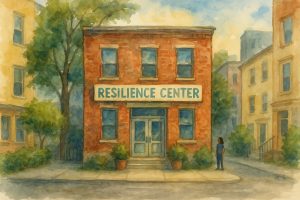
Image credit: ChatGPT
Earlier this semester, I listened to an interview with Eric Klinenberg, the author of Palaces for the People. Klinenberg tells the story of working with a design competition where one team excitedly shared their concept for new “resilience centers.” They described the idea as spacious buildings with flexible-use areas located in vulnerable neighborhoods. These centers would be open as much as possible, with extremely welcoming staff, and designed to meet the community’s needs. Klinenberg applauded the group’s concept and then asked, ‘Have you ever heard of a library?’” (Mars, 2019, 10:05).
That story stuck with me because I think the term “resilience center” really captures the essence of libraries. Not only do libraries help individuals and whole communities build resilience, but libraries themselves have proven to be resilient institutions.
Libraries have evolved from being “book places” to providing an amazing range of programs and services for people. From Sacramento’s Rolling Library Train (Sacramento Regional Transit, 2022), which allows commuters to connect with digital materials while using public transportation, to libraries that can be accessed whenever patrons want (Holmquist, 2016), to the rooftop movie night at the Vinton Branch of the Roanoke County Public Library (Shook, 2019), libraries provide unique designs and services geared toward the particular needs of the communities they serve. That’s often what is so exciting about visiting a new library: each location is unique.
How can libraries stay relevant in a rapidly changing world? One key lesson from new library models is that there is no one-size-fits-all solution. “Since every community is unique, it stands to reason each library differs in response to their customers’ needs and providing services that make them essential” (VerKuilen, 2023). Libraries thrive when rooted in their communities, listening carefully and responding creatively.
That means the most successful libraries are those that remain flexible. Agility is essential, whether that involves experimenting with new access models, hosting unexpected programs, or adapting spaces to meet evolving local needs (Shook, 2019). We can’t always predict what communities will need next, but we can build resilient institutions prepared to adapt when those needs change.
References
Holmquist, J. (2016, April 6). Open libraries: Self-service libraries – The Danish way. Jan Holmquist: World wide thoughts of a Danish librarian. https://janholmquist.net/2016/04/06/open-libraries-self-service-libraries-the-danish-way/
Mars, R. (Host). (2019, March 19). Palaces for the people (No. 346) [Audio podcast episode]. In 99% Invisible. https://99percentinvisible.org/episode/palaces-for-the-people/
VerKuilen, C. (2023, February 9). Centering your library around the community. Library Journal. https://www.libraryjournal.com/story/centering-your-library-around-the-community-lj230207
Shook, S. (2019, August 6). Breaking the model: How community-centered libraries celebrate equity, diversity, and inclusivity. Library Journal. https://www.libraryjournal.com/story/breaking-the-model-how-community-centered-libraries-celebrate-equity-diversity-and-inclusivity
Sacramento Regional Transit. (2022, September 6). Ride and read on Sacramento’s rolling library [Video]. YouTube. Https://www.youtube.com/watch?v=f7GMWYha-0U
